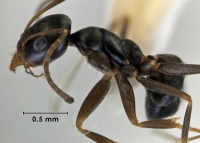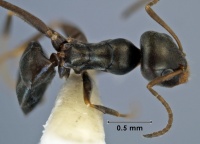Iridomyrmex continentis
| Iridomyrmex continentis | |
|---|---|

| |
| Scientific classification | |
| Kingdom: | Animalia |
| Phylum: | Arthropoda |
| Class: | Insecta |
| Order: | Hymenoptera |
| Family: | Formicidae |
| Subfamily: | Dolichoderinae |
| Tribe: | Leptomyrmecini |
| Genus: | Iridomyrmex |
| Species: | I. continentis |
| Binomial name | |
| Iridomyrmex continentis Forel, 1907 | |
Iridomyrmex continentis is frequently encountered in drier areas of Australia. Collections have been made in pitfall traps and by hand.
Identification
Iridomyrmex continentis is a small-medium, rather nondescript brown ant. The worker can easily be mistaken for that of Iridomyrmex mjobergi, a species with which it is often sympatric, but the slightly longer antenna and the posteriorly flattened propodeum, with the propodeal spiracle placed near the dorsum of the sclerite, will help identify this taxon.
Keys including this Species
Distribution
Latitudinal Distribution Pattern
Latitudinal Range: -22.5358° to -30.91667°.
| North Temperate |
North Subtropical |
Tropical | South Subtropical |
South Temperate |
- Source: AntMaps
Distribution based on Regional Taxon Lists
Australasian Region: Australia (type locality).
Distribution based on AntMaps
Distribution based on AntWeb specimens
Check data from AntWeb
Countries Occupied
| Number of countries occupied by this species based on AntWiki Regional Taxon Lists. In general, fewer countries occupied indicates a narrower range, while more countries indicates a more widespread species. |

|
Estimated Abundance
| Relative abundance based on number of AntMaps records per species (this species within the purple bar). Fewer records (to the left) indicates a less abundant/encountered species while more records (to the right) indicates more abundant/encountered species. |

|
Biology
Castes
Nomenclature
The following information is derived from Barry Bolton's Online Catalogue of the Ants of the World.
- continentis. Iridomyrmex mattiroloi var. continentis Forel, 1907h: 290 (w.q.m.) AUSTRALIA. Raised to species: Heterick & Shattuck, 2011: 66.
Type Material
- Iridomyrmex mattiroloi continentis: Syntype, 2 workers, 1 queen, Denham and Kalgoorlie, Western Australia, Australia, Musee d'Histoire Naturelle Genève.
- Iridomyrmex mattiroloi continentis: Syntype, 1 worker, Denham and Kalgoorlie, Western Australia, Australia, Western Australian Museum.
Description
Worker Description. Head. Posterior margin of head weakly convex to planar; erect setae on posterior margin in full-face view, present in small aggregations on one or both sides of posterior margin of head, or absent; sides of head noticeably convex; erect genal setae absent from sides of head in full-face view (one to a few small setae may be present near mandibular insertion). Ocelli absent; in full-face view, eyes set at about midpoint of head capsule; in profile, eye set anteriad of head capsule; eye asymmetrical, curvature of inner eye margin more pronounced than that of its outer margin. Frontal carinae straight; antennal scape surpassing posterior margin of head by approximately 2 x its diameter. Erect setae on scape absent, except at tip; prominence on anteromedial clypeal margin present as an indistinct swelling or undulation; mandible regularly triangular with oblique basal margin; long, curved setae on venter of head capsule absent. Mesosoma. Pronotum moderately and evenly curved over its length. Erect pronotal setae sparse to absent. Mesonotum evenly curved. Erect mesonotal setae sparse to absent. Mesothoracic spiracles always inconspicuous; propodeal dorsum tapered posteriad; placement of propodeal spiracle posteriad and near confluence of propodeal dorsum and propodeal declivity; propodeal angle weakly present or absent, the confluence of the dorsal and declivitous propodeal faces indicated, if at all, by an undulation. Erect propodeal setae sparse (6 or fewer) and bristly. Petiole. Dorsum of node convex; node thin, scale-like, orientated anteriad. Gaster. Non-marginal erect setae of gaster present or absent on first gastral tergite; marginal erect setae of gaster present on first tergite, or absent on first tergite. General characters. Allometric differences between workers of same nest absent. Colour medium to dark metallic brown, head and body with coppery reflections. Colour of erect setae brownish-yellow.
Measurements. Worker (n = 6)—CI 86–91; EI 29–32; EL 0.16–0.21; EW 0.13–0.17; HFL 0.77–1.13; HL 0.60–0.83; HW 0.52–0.71; ML 0.70–1.15; MTL 0.54–0.78; PpH 0.07–0.12; PpL 0.32–0.49; SI 101–118; SL 0.59– 0.84.
References
- Heterick, B.E. & Shattuck, S.O. 2011. Revision of the ant genus Iridomyrmex (Hymenoptera: Formicidae). Zootaxa 2845: 1-175.
- Heterick, B.E. 2021. A guide to the ants of Western Australia. Part I: Systematics. Records of the Western Australian Museum, Supplement 86, 1-245 (doi:10.18195/issn.0313-122x.86.2021.001-245).
- Heterick, B.E. 2022. A guide to the ants of Western Australia. Part II: Distribution and biology. Records of the Western Australian Museum, supplement 86: 247-510 (doi:10.18195/issn.0313-122x.86.2022.247-510).
References based on Global Ant Biodiversity Informatics
- Clark J. 1938. The Sir Joseph Banks Islands. Reports of the McCoy Society for Field Investigation and Research. Part 10. Formicidae (Hymenoptera). Proceedings of the Royal Society of Victoria (n.s.)50: 356-382.
- Gunawardene N.R. and J.D. Majer. 2004. Ants of the southern Carnarvon Basin, Western Australia: an investigation into patterns of association. Records of the Western Australian Museum 22: 219-239.
- Heterick B. E., B. Durrant, and N. R. Gunawardene. 2010. The ant fauna of the Pilbara Bioregion, Western Australia. Records of the Western Australian Museum, Supplement 78: 157-167.
- Heterick B. E., and S. Shattuck. 2011. Revision of the ant genus Iridomyrmex (Hymenoptera: Formicidae). Zootaxa 2845: 1-174.
- Shattuck S. O. 1994. Taxonomic catalog of the ant subfamilies Aneuretinae and Dolichoderinae (Hymenoptera: Formicidae). University of California Publications in Entomology 112: i-xix, 1-241.

